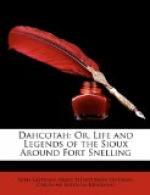Walking Wind was not so easily won. She had been tormented so long herself, that she was in duty bound to pay back in the same coin. It was a Duncan Gray affair—only reversed. At last she yielded; her lover gave her so many trinkets. True, they were brass and tin; but Dahcotah maidens cannot sigh for pearls and diamonds, for they never even heard of them; and the philosophy of the thing is just the same, since everybody is outdone by somebody. Besides, her lover played the flute all night long near her father’s wigwam, and, not to speak of the pity that she felt for him, Walking Wind was confident she never could sleep until that flute stopped playing, which she knew would be as soon as they were married. For all the world knows that no husband, either white or copper-colored, ever troubles himself to pay any attention of that sort to his wife, however devotedly romantic he may have been before marriage.
Sometimes the Dahcotah lover buys his wife without her consent; but the War Club was more honorable than that: he loved Walking Wind, and he wanted her to love him.
When all was settled between the young people, War Club told his parents that he wanted to marry. The old people were glad to hear it, for they like their ancient and honorable names and houses to be kept up, just as well as lords and dukes do; so they collected everything they owned for the purpose of buying Walking Wind. Guns and blankets, powder and shot, knives and trinkets, were in requisition instead of title-deeds and settlements. So, when all was ready, War Club put the presents on a horse, and carried them to the door of Walking Wind’s wigwam.
He does not ask for the girl, however, as this would not be Dahcotah etiquette. He lays the presents on the ground and has a consultation, or, as the Indians say, a “talk” with the parents, concluding by asking them to give him Walking Wind for his wife.
And, what is worthy to be noticed here is, that, after having gone to so much trouble to ask a question, he never for a moment waits for an answer, but turns round, horse and all, and goes back to his wigwam.
The parents then consult for a day or two, although they from the first moment have made up their minds as to what they are going to do. In due time the presents are taken into the wigwam, which signifies to the lover that he is a happy man. And on the next day Walking Wind is to be a bride.
CHAPTER V.
Early in the morning, Walking Wind commenced her toilet—and it was no light task to deck the Indian bride in all her finery.
Her mocassins were worked with porcupine, and fitted closely her small feet; the leggins were ornamented with ribbons of all colors; her cloth shawl, shaped like a mantilla, was worked with rows of bright ribbons, and the sewing did honor to her own skill in needle-work. Her breast was covered with brooches, and a quantity of beads hung round her neck. Heavy ear-rings are in her ears—and on her head is a diadem of war eagle’s feathers. She has a bright spot of vermilion on each cheek, and—behold an Indian bride!




